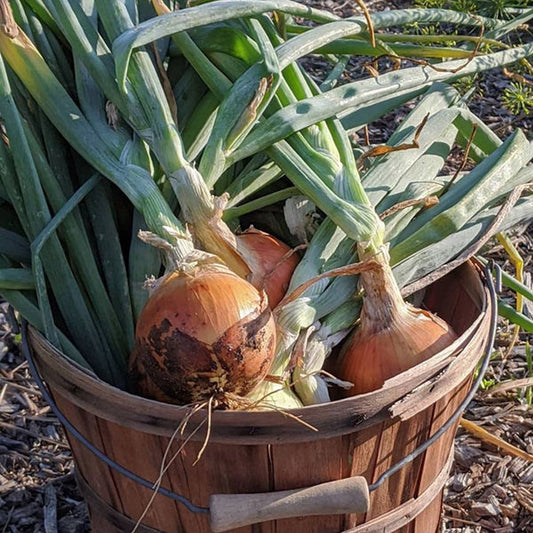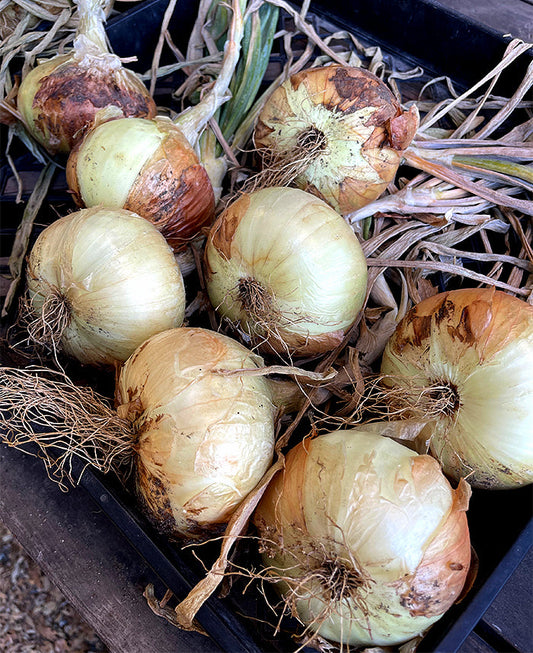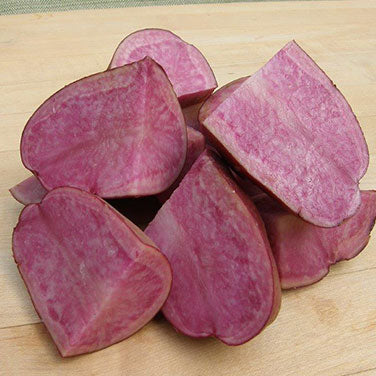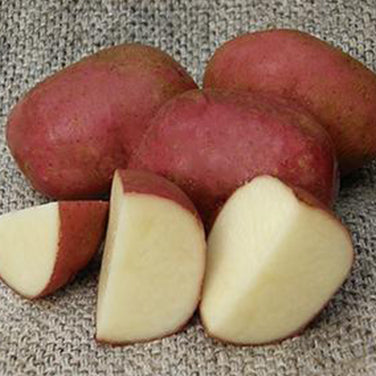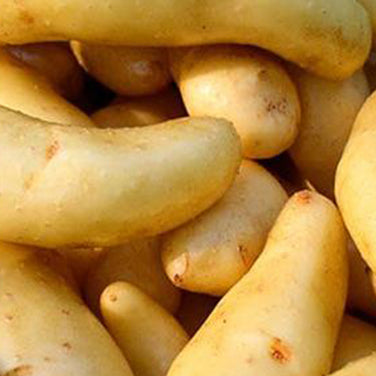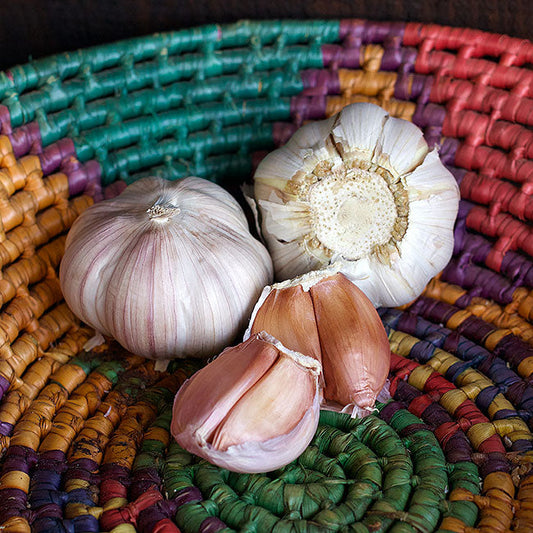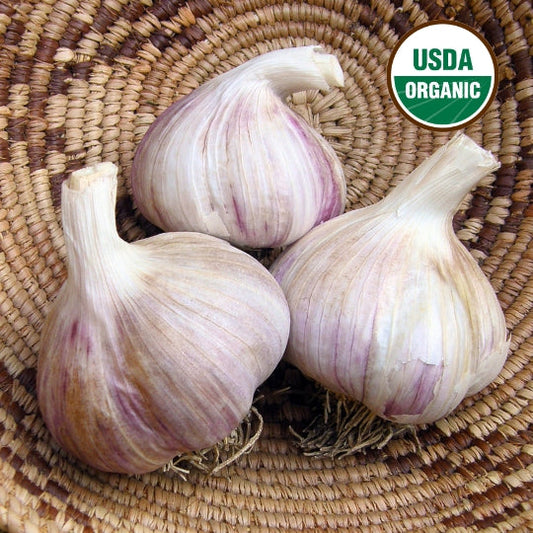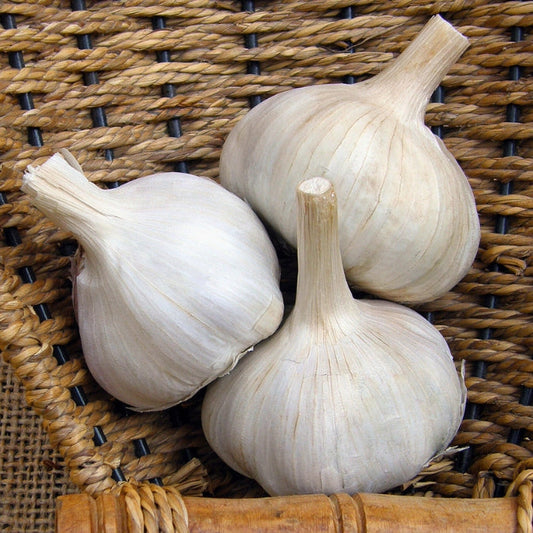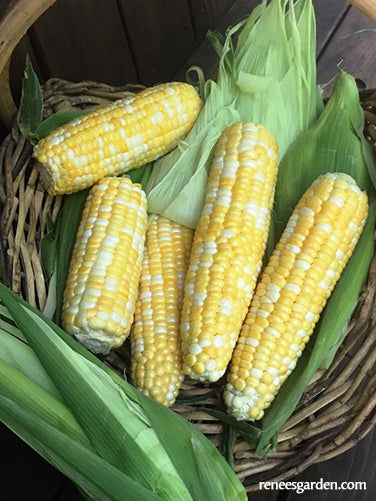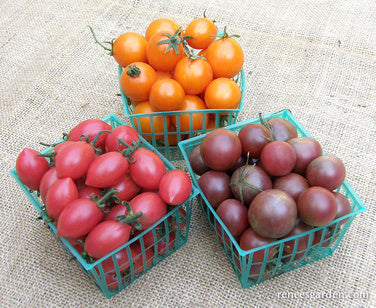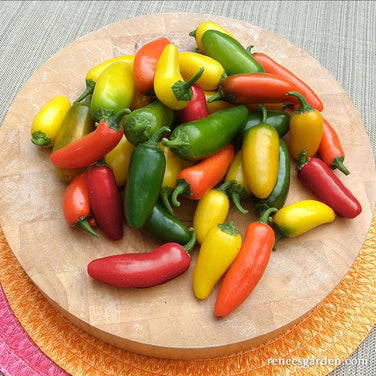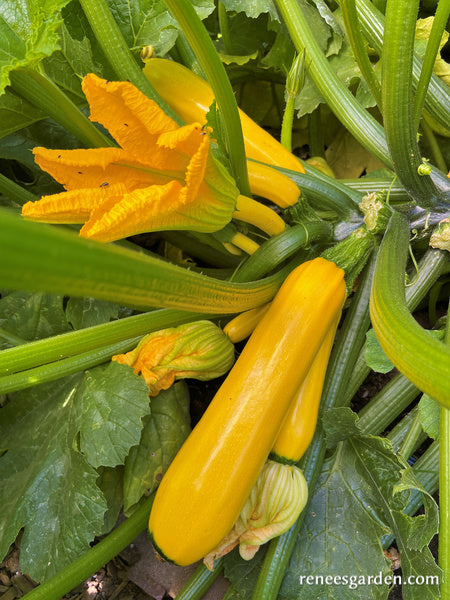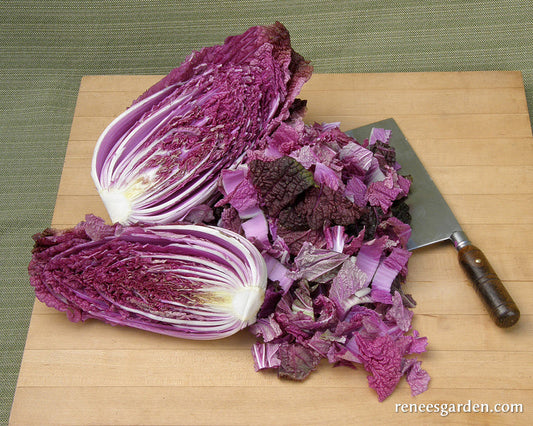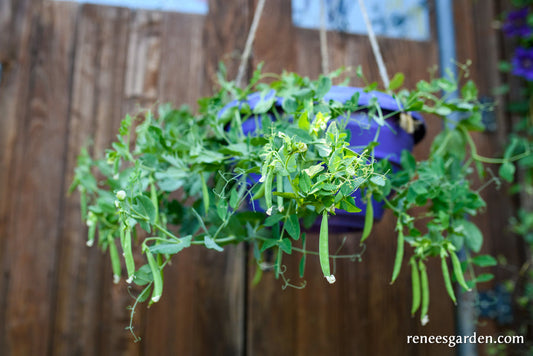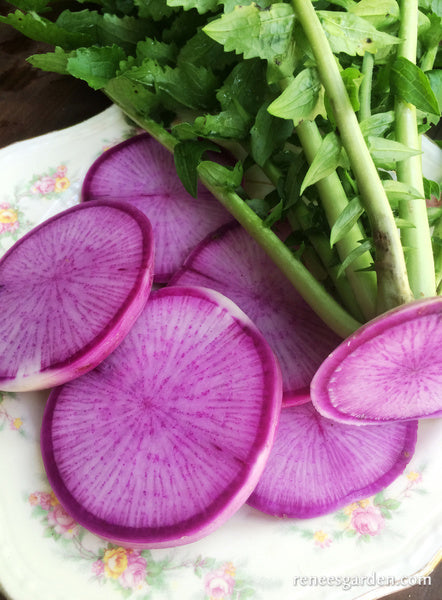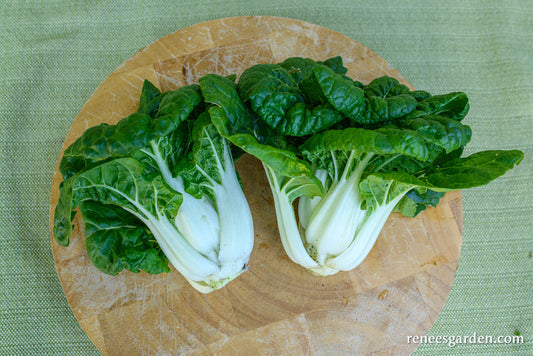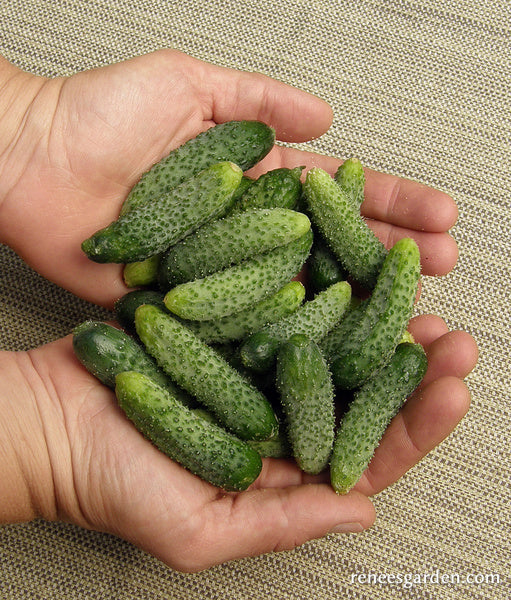Vegetables
Set The Table From Your Garden
-
Long Keeping Onions Patterson Long Keeping
Patterson is the best variety for gardeners in the Northeast, and Northern parts of the Midwest who want rich, full flavored onions for extended storage. Hybrid Patterson has layered bronze wrapper skins that stay intact, protecting the dense yellow flesh.
These uniform, globe-shaped 3 inch bulbs are pungent and full-flavored main dish onions, well-suited to a wide range of stewing, sautéing, and baking uses and a top choice for homemade onion rings and long cooking soups and stews. Excellent keepers, easy to grow and rot resistant, crispy Patterson will be your staple at a storage potential of 9 to 12 months.
5 dozen plantsRegular price $22.95Sale price $22.95Unit price / per -
Sweet and Mild Onions Walla Walla Sweet
Long celebrated for their succulent, sweet, mild flesh, Walla Walla Sweets have been favorites since the early 1900s when they were originally brought here from France. These big, yellow, semi-flat yellow skin bulbs have crunchy white flesh that is simply delicious either raw or cooked. We like them just baked in their own papery skins like a russet potato – they are that good!
Walla Walla plants will produce harvests all over the long and intermediate day areas of the country, but pungency will vary depending on your climate and garden soil. They are short keepers, so enjoy them for 4 to 6 weeks after harvest for their exceptional flavor.
5 dozen plantsRegular price $22.95Sale price $22.95Unit price / per -
Terra Rosa
Terra Rosa is a full-sized, oblong variety with smooth, deep magenta skin and pink-red sweet, creamy flesh that ranks high for flavor. This high nutrient specialty potato is really handsome, but its good looks are not just skin deep, because Terra Rosa’s rich color means higher levels of bioactive antioxidants and protective carotenoids. They retain their rosy color and resist fading when cooked.
Great tasting Terra Rosa tubers are ideal for microwaving, frying and we love them as oven-baked fries. You’ll find them perfect to harvest early, at 1 1/2 to 2 inches, and quickly steam for a baby potato feast. Harvesting, some as new potatoes early won’t mean fewer big ones later either, because Terra Rosa offers strong yields. Stores well for later use.
Early to Midseason: 80-95 days / Type: Indeterminate
1 lb. bag (plants a 10 foot row)
Mix and match your own potato patch:
Save 10% when you buy any 3 varieties or more!
Discount taken at checkoutRegular price $19.95Sale price $19.95Unit price / per -
Dark Red Norland
These large, rounded potatoes have deep red, almost burgundy colored skins and contrasting bright white flesh. A good choice when you want to dig some early for little red skinned baby potatoes, then leave the plants to produce full-size potatoes for later harvest.
Dark Red Norland tastes moist and smooth with a sweet, delicate flavor and they make great tasting mashed potatoes. These vigorous plants produce big, round to oblong, slightly flattened potatoes with shallow eyes that bulk up rapidly for early harvests. You'll relish them for weeks whether you eat them simply boiled, mashed, hashed or in potato salads. Dark Red Norland potatoes are widely adapted, and store very well.
Early: 60-75 days / Type: Determinate
1 lb. bag (plants a 10 foot row)
Mix and match your own potato patch:
Save 10% when you buy any 3 varieties or more!
Discount taken at checkoutRegular price $19.95Sale price $19.95Unit price / per -
Heirloom Russian Banana Fingerlings
These oblong fingerling potatoes originally came from the Baltic region of Northeastern Europe. Tender Russian Banana potatoes have thin skins with firm, buttercream colored delicious flesh. They range in size from 3 to 4 inches long, with dense flesh that cooks up solid, keeps its shape well and slices neatly.
These gourmet fingerlings have a rich, chestnuty flavor and waxy texture perfect in potato salads. You'll love them slowly roasted with whole garlic cloves, steamed to serve hot and fragrant with butter and rosemary or parboiled to skewer for the barbecue. Russian Bananas are heavy producers, good keepers, widely adapted and drought tolerant.
Late: 95-125 days / Type: Indeterminate
1 lb. bag (plants a 10 foot row)
Mix and match your own potato patch:
Save 10% when you buy any 3 varieties or more!
Discount taken at checkoutRegular price $19.95Sale price $19.95Unit price / per -
Spanish Roja
A prize for all serious garlic lovers, heirloom Spanish Roja is a hardneck rocambole garlic renowned for its complex, rich flavor. Originally brought to the Pacific Northwest in the late 1800s, Spanish Roja is a longtime regional favorite that fully deserves its stellar taste reputation among discerning cooks everywhere.
Spanish Roja bulb wrappers are white or lightly striped, with plump and especially easy to peel red-skinned cloves. You’ll love Roja’s superbly rich, spicy flavor. Early-midseason maturity.
See All Garlic and Shallots
1/2 lb. bag (3-6 full heads) / HardneckRegular price $17.95Sale price $17.95Unit price / per -
Sweet and Mild Onions Yellow Granex Super Sweet
This is the really sweet variety grown in both Vidalia, Georgia and Maui, Hawaii, then marketed by those place names as Vidalia or Maui onions. These semi-flattened, big, fat, crispy hybrid onions are so mild that you can eat them out of hand. Juicy slices are really scrumptious on burgers.
Our grower ships over 100 million of these plants to be transplanted in Vidalia every year. While they may not grow as sweet in your own garden soil, you're sure to enjoy them. With their paper thin skins, these onions keep for only up to a month, but by that time they'll be all gone!
5 dozen plantsRegular price $22.95Sale price $22.95Unit price / per -
German Porcelain Extra Hardy
Hardneck German Porcelain garlic produces impressively large bulbs, up to 3 inches in diameter, with thick, translucent white wrapper leaves. Inside you’ll find 4 to 6 very large, juicy, easy to peel cloves.
This richly flavored, robust garlic is strong and hot, perfect for robust recipes like pesto, marinara or cioppino for a big punch of rich garlic flavor. When used in slow cooked dishes, its spicy flavor mellows beautifully; enjoy in stews, soups, grains and beans, roasts and poultry.
German Porcelain thrives in cold weather. Keeps for many months. Midseason harvest.
See All Garlic and Shallots
1/2 lb. bag (3-6 full heads) / HardneckRegular price $19.95Sale price $19.95Unit price / per -
Chesnok Red
Hardy Chesnok Red, originally from the Republic of Georgia, is easily one of the most colorful garlic varieties we offer. It yields heavy, tightly wrapped striped heads whose 6 to 10 easy to peel cloves have cranberry tinted skins.
Chesnok Red has a well-balanced flavor for eating raw, and when cooked it becomes gentle, earthy and rich with smooth sweetness and just a touch of heat. Wonderful roasted. This is the best variety to use for making garlic ice cream!
Chesnok Red can handle poor soil more readily than other varieties and, like all hardneck varieties, it is a reliably long keeper. Mid-season harvest.
See All Garlic and Shallots
1/2 lb. bag (3-6 full heads) / HardneckRegular price $19.95Sale price $19.95Unit price / per -
Killarney Red
Killarney Red is a high yielding Rocambole garlic with heads that have 7 to 9 good sized cloves around a central stalk. The juicy cloves are loosely wrapped, so you can quickly break apart the heads and peel the papery mahogany skins off individual cloves.
Killarney Red has a strong, nutty, rich garlic flavor that makes it a good all-purpose garlic. It is very popular with many restaurant chefs because of its fine full-bodied garlic flavor combined with fast and easy kitchen prep.
This variety does well in both cold weather and wet but well-drained conditions. A medium keeper. Early to mid-season harvest.
See All Garlic and Shallots
1/2 lb. bag (3-6 full heads) / HardneckRegular price $17.95Sale price $17.95Unit price / per -
Bicolor Corn My Fair Lady
START SEEDS OUTDOORS
In spring, once weather is warm and settled and night temperatures stay securely above 55°F (13°C), plant seeds in well-worked, fertile soil in full sun. Poke seeds in 1 inch deep and 4 to 6 inches apart. Plant in a block of 4 side-by-side rows, each row at least 1 foot apart.
Thin seedlings to 1 foot apart when several inches tall. Protect from marauding birds if necessary. If first sowing doesn’t germinate evenly, replant right away as new seedlings catch up quickly. Make several sowings 2 or 3 weeks apart until early June to have successive harvests.
GROWING NOTES
Plant seeds in blocks of at least 4 parallel rows to ensure good wind pollination and well filled out ears. Corn is a heavy feeder, so add plenty of compost or aged manure to the soil at sowing time, and then fertilize when young plants are 10 to 12 inches tall and again as ears begin to form.
HARVEST AND USE
Well filled out ears of corn are ready to eat when the silks are very dark brown but not dried out. Test by choosing a plump ear and peeling back the husk very slightly. The kernels should be tender and milky when slit with a fingernail. My Fair Lady is an SE corn, so the tender crisp kernels will hold their sweetness after harvest.Regular price $4.89Sale price $4.89Unit price / per -
Cherry Tomato Trio Triple Treats
STARTING SEEDLINGS
Start indoors about 6 to 8 weeks before outdoor night temps are in the 50-55°F (10-13°C) range. Sow seeds ¼ inch deep and 1 inch apart in a container of seed starting mix. Keep moist but not soggy, and very warm, 80°F (27°C). Provide a strong light source until seedlings are ready to plant outside.
When they are 2 inches tall, transplant into 4 inch pots, burying stems up to base of leaves. Maintain around 70°F (21°C). Feed with half-strength fertilizer every 2 weeks until weather is warm enough to gradually acclimate seedlings to outdoor conditions. Transplant these vigorous indeterminate climbers 3 feet apart into rich soil in full sun.
GROWING NOTES
Prepare soil well with aged manure or compost. Plant tomatoes several inches deeper than they were growing in pots. Provide strong stakes or tall wire cages at planting time as plants grow tall with heavy fruit loads. Mulch to provide the even moisture that prevents cracking. Don’t overwater once fruit begins to ripen.
HARVEST AND USE
Harvest when fully colored up to enjoy as sweet snacks, in salads or quickly sautéed in olive oil with fresh herbs.
Regular price $4.89Sale price $4.89Unit price / per -
Sangre
Sangre is one of the prettiest of all red skinned varieties, with shallow eyes and medium-sized oblong tubers. Originally released by Colorado State University in 1982, Sangre ranks high in taste tests with creamy white flesh that is especially delicious boiled or baked. Think roasted with whole garlic cloves or starring in a warm German potato salad.
Sangre plants emerge slowly but grow rapidly. Plants have concentrated, shallow roots with high yields for easy harvest. Because Sangre bulks up quickly, it is a good choice to dig for early new potatoes. Mature tubers store well.
Midseason: 80-95 days / Type: Indeterminate
1lb. bag (plants a 10-foot row)
Mix and match your own potato patch:
Save 10% when you buy any 3 varieties or more!
Discount taken at checkoutRegular price $19.95Sale price $19.95Unit price / per -
Giant Harvest Gourds Lunch Lady
BEST TO START SEEDS INDOORS
Several weeks before last spring frost date, sow 2 seeds each, 1 in. deep, in individual pots of potting mix. Keep warm and moist and provide a strong light source. When nights stay above 50°F (10°C), thin to one seedling per pot and gradually acclimate to outdoors. Transplant at along a sturdy fence or trellis to climb effortlessly and form a lush canopy or allow vines to ramble at garden edges.
START DIRECTLY OUTDOORS
Sow seeds directly outdoors only if you have a long growing season. Sow only after night temperatures stay solidly above 50°F. (10°C). In full sun, sow seeds 1 inch deep and 4 inches apart along a garden fence or sturdy trellis or along garden edges. Thin seedlings to final spacing 8 inches apart.
GROWING NOTES
Unique Lunch Lady gourds need full sun, rich soil and warm temperatures. For earliest and best yields, hand-pollinate gourds: pick a blooming male flower and dust pollen onto fresh female flowers (the ones with small fruits at the base).
Repeat as new flowers appear. Pollinated fruits start growing larger within several days. Gourds are mature when rinds are tough and the tendril next to the stem turns brown. Harvest with several inches of stem. Dry in a well-ventilated place.
Note: the flesh of Lunch Lady ornamental gourds has a bitter gene and is not edible.Regular price $4.69Sale price $4.69Unit price / per -
Rainbow Jalapeño Chiles Spice Trio
STARTING SEEDLINGS
In early spring, start indoors about 2 months before night temperatures stay reliably 55°F (13°C). Sow seeds 1/4 inch deep and 1 inch apart in a container of seed starting mix. Keep moist but not soggy, and very warm 80-85°F (27-30°C). Provide a strong light source until seedlings are ready to plant outside.
When seedlings are 2 inches tall, transplant into deeper individual containers. Maintain at 70-75°F (21-24°C). Feed with half-strength fertilizer every week until weather is warm enough to gradually acclimate seedlings to outdoor conditions. Transplant 1 1/2 feet apart into rich soil in full sun.
GROWING NOTES
Jalapeños need warm conditions. Don’t transplant outdoors until night temperatures stay securely above 55°F (13°C). Prepare soil well with aged manure or compost. Plant only robust seedlings with well-developed roots. Mulch plants to maintain even soil moisture. Keep well weeded, watered and fertilized.
HARVEST AND USE
To harvest, cut rather than pull fruits from plants when fully colored up either bright red, rich orange or golden-yellow. These eye-catching, spicy baby jalapenos have thick juicy flesh. Slice and pickle them for zesty condiments, use for delicious rainbow salsas, fajitas or for cheese stuffed “poppers.”Regular price $4.89Sale price $4.89Unit price / per -
Bush Beans Heirloom Cannellini
START SEEDS OUTDOORS
Don’t plant too early; cold conditions prevent good bean germination. In late spring, when nights are securely above 55°F (13°C), sow seeds in well worked, fertile soil in full sun. Poke seeds in 1 inch deep and 4 inches apart in rows 1 1/2 to 2 feet apart.
GROWING NOTES
If first sowing comes up unevenly, replant right away; new seedlings catch up quickly. Bean seedlings are tempting treats to birds; watch carefully and protect with netting if necessary.
HARVEST AND USE
When the beans are hard and smooth inside dry and leathery pods, harvest the whole crop at once, or, if frost or excessive rain threatens, pull entire plants and finish drying in a sheltered spot. Shell out the completely dry beans by hand or put whole pods in a pillowcase and whack it on the ground to “spill the beans” from pods. Put cleaned, shelled beans in freezer for 3 to 4 days to eliminate any insects, then store in glass jars in a cool dry place. Check out YouTube/Renees Garden for harvesting video!
Note: freshly grown dry beans will cook faster than store bought ones. Soak overnight first, then cook up with a bay leaf, garlic and savory herbs.
Regular price $3.99Sale price $3.99Unit price / per -
Heirloom Zucchini Summer Gold
START SEEDS DIRECTLY IN THE GARDEN
Zucchinis need full sun, rich fertile soil and warm temperatures. Plant only when spring weather is warm and settled and night temperatures stay above 50°F (10°C). Sow groups of 2 to 3 seeds 1 inch deep and 2 feet apart. When seedlings have 4 leaves, thin to 1 strong seedling per group. Or, plant in slightly mounded hills, 2 feet in diameter, sowing 4 or 5 seeds in each hill. Thin hill-planted seedlings to the 2 or 3 strongest plants.
GROWING NOTES
Amend soil well before sowing with lots of aged manure or compost. Protect young seedlings from marauding birds by covering with plastic berry baskets at planting time, removing when plants get crowded. Be sure to thin properly—you will have more productive, disease-free plants if seedlings have enough room to mature. covers will help prevent squash borers if these pests are a problem in your area.
HARVEST AND USE
Harvest zucchini when no more than 5 to 6 inches long for best flavor. Frequent harvesting keeps plants producing tasty new fruits instead of maturing fat, tough, huge ones. Steam, stirfry or grill sliced zucchinis and sprinkle with fresh parsley, dill, basil or thyme. Try the tasty blossoms sautéed or stuffed and baked. Heap a platter with spears of baby zucchinis to serve with your favorite dip for appetizers or snacks.
Regular price $4.89Sale price $4.89Unit price / per -
Napa Cabbage Purple Express
TO START INDOORS
Start seeds 4 to 5 weeks before last spring frost. Sow 1 inch apart in seed starting mix, cover 1/4 inch deep and keep evenly moist. Provide a strong light source until seedlings are ready to plant out. When several inches tall, transplant seedlings 10 inches apart into rich soil in full sun, after gradually acclimating to outdoor conditions.
TO START DIRECTLY OUTDOORS
When all danger of frost is over, plant in well-worked, fertile soil in full sun. Sow clusters of 2 to 3 seeds 10 inches apart in rows spaced 1 foot apart. When seedlings are several inches tall, thin to 1 strong plant every 10 inches. In mild winter climates, sow seeds again at midsummer for a fall crop.
GROWING NOTES
Purple Express needs full sun and rich, well-drained soil to produce firm, sweet heads. To avoid stunting growth, don’t let seedlings get crowded before thinning or transplanting. Keep weeded and evenly watered. Feed monthly with fish emulsion or an all-purpose fertilizer. Use non-toxic B.T. (Bacillus thuringiensis) for caterpillar pests. Floating row covers provide a good barrier method to exclude pests. Remove covers when heads begin to form.
HARVESTING
Cut the whole cabbage at ground level only when these tall, vase-shaped heads are very solid and about 6-8 inches in diameter.
Regular price $4.69Sale price $4.69Unit price / per -
Heirloom Popcorn Mini Pink Pearls
START SEEDS OUTDOORS
In spring, once weather is warm and settled and night temperatures stay securely above 55°F (13°C), plant seeds in well-worked, fertile soil in full sun. Poke seeds in 1 in. deep and 4 to 6 in. apart. Plant in a block of 4 side-by-side rows, each row at least 1 ft. apart. Thin seedlings to 1 ft. when several in. tall. Protect from marauding birds if necessary. If first sowing doesn’t germinate evenly, replant right away as new seedlings catch up quickly.
GROWING NOTES
Plant seeds in blocks of at least 4 parallel rows to ensure good wind pollination and well filled out ears. Corn is a heavy feeder, so add plenty of compost or aged manure to the soil at sowing time, and then fertilize when young plants are 7 to 8 in. tall and again as ears begin to form.
HARVESTING
Wait to harvest popcorn until ears are mature, husks are dry, and kernels are dry and hard. To shuck the kernels from the cobs, break the cob in half and pop the kernels off starting from the edge, using your fingertips or a dull butterknife, letting kernels fall into a bowl. Once a section is started, the kernels pop off the cob easily.
After shucking the kernels from cobs, spread kernels out in a shallow layer on rimmed pans. Let them dry down for at least 2-3 weeks in a warm, dry room with good air circulation. Then store in airtight jars. Drying the kernels thoroughly will increase how well they pop.
Regular price $3.99Sale price $3.99Unit price / per -
Hanging Basket Snap Peas Snack Hero
START SEEDS OUTDOORS
In early to mid-spring, plant peas in full sun in well-worked, fertile soil. Sow 1 inch deep and 3 inches apart. Protect from marauding birds with netting or floating row covers if necessary. Wet, cold early spring weather may affect germination, so if first sowing doesn’t germinate evenly, replant right away: new seedlings catch up quickly. Sow again for a fall crop, several months before fall frosts.
CONTAINERS, BASKETS AND WINDOW BOXES
Plant in containers at least 15-18 inches in diameter and 7-10 inches deep. When seedlings are 2-3 inches long, thin to 3 inches apart, so each little vine has growing room. Mulch to conserve moisture. Feed with all-purpose fertilizer every 2-3 weeks. If it gets hot, check and water containers daily; otherwise, water when the top inch of soil is dry. Water at base of the plants to avoid mildew.
HARVEST AND USE
Harvest only when peas are mature and rounded in the thick-walled, juicy pods for the best developed flavor. Savor their sweet crunch fresh (kids especially love them!) as a snack or slice into salads. To cook quickly, pull strings from pods and sauté in a little oil just until pods turn a deeper green color.
Regular price $3.69Sale price $3.69Unit price / per -
Daikon Radish Mini Purple
START SEEDS OUTDOORS
In early spring as soon as ground can be worked, sow daikon radish seeds in a sunny spot with well-drained soil. Space seeds 2-3 inches apart in rows 6 inches apart. Cover 1/2 inch deep. Keep soil evenly moist and well weeded. If first sowing comes up unevenly, replant right away. Sow again in mid summer for a fall crop.
GROWING NOTES
For crispy flesh and mild flavor, give daikon radishes consistent moisture. When they are several inches tall, carefully thin seedlings to 3-4 inches apart, so the roots have room to size up and mature. Enjoy early thinnings in salads. Protect radishes with floating row covers if marauding birds or flea beetles that chew holes in the leaves are a problem.
HARVEST AND USE
If weather turns unexpectedly hot, pull, cut off tops and store the roots in the refrigerator where they keep very well. Daikon radish flavor is spicier in hot weather and milder in cool conditions. Slice and eat fresh, add to salads, shred for coleslaw or enjoy in stirfries, soups, and stews. Flavor is milder when cooked. Mini Purple daikon are delicious pickled in rice vinegar and will make a crunchy, colorful kimchee!
Regular price $4.69Sale price $4.69Unit price / per -
Mini Pak Choi Green Jewel
TO START OUTDOORS
In very early spring as soon as ground can be worked, prepare a well-drained, fertile garden bed in full sun. Sow seeds 2 inches apart in rows spaced 6 to 8 inches apart. Cover 1/4 inch deep and keep soil evenly moist to ensure good germination. Sow again in late summer for another fast growing crop.
TO START INDOORS
Sow seeds in a container of seed starting mix 2 inches apart and cover 1/4 inch deep. Keep moist and provide a strong light source until seedlings are about 3 inches tall and ready to plant in the garden.
THIN OR TRANSPLANT
Space seedlings 3-4 inches apart to give plants room to mature.
GROWING NOTES
Pak Choi thrives in rich soil and cool growing conditions. Be sure to thin seedlings and keep well weeded and watered for best tasting crunchy heads. Feed 2 or 3 times during the growing season with fish emulsion or another high nitrogen fertilizer.
HARVEST AND USE
Harvest these plump minis when heads are solid and well filled out. Cut in half and sauté briefly, until just tender, then finish with a little soy sauce and toasted sesame oil. Or enjoy their mild sweet crunch in any stirfry, but don’t overcook. Mini Pak Choi is succulent, crunchy- sweet and mild tasting, and chock full of vitamins.
Regular price $3.69Sale price $3.69Unit price / per -
Petite Pickles French Cornichon
START SEEDS OUTDOORS
Plant heat loving cucumbers only when weather is warm and settled and night temperatures stay above 50°F (10°C). Amend soil well with aged manure or compost. Sow groups of 2 to 3 seeds 1 1/2 feet apart and 1 inch deep with 3 feet between rows.
Thin to 1 seedling per group. Or make slightly mounded hills 5 feet apart, sowing 5 or 6 seeds in each hill. Thin to the 3 strongest plants.
GROWING NOTES
Protect seedlings from marauding birds with plastic berry baskets, removing before plants get crowded. Shallow rooted cucumbers need ample and consistent moisture. Avoid overly wet or dry periods for good quality fruit. Growing cucumber vines up vertical supports saves garden space and makes it easy to find and harvest the cucumbers.
HARVEST AND USE
IMPORTANT: Harvest by cutting when just 1 1/2 to 2 inches long. Harvest every few days to keep vines producing and the cornichons from getting too big! Put up pickles within a few days of harvest.
Pickle tiny cornichons in a simple vinegar solution with garlic, peppercorns and fresh tarragon or dill. Traditional with pâté and delicious as snacks or with cocktails.
Regular price $4.69Sale price $4.69Unit price / per -
Organic Climbing Zucchini Incredible Escalator
START SEEDS OUTDOORS
Squash needs full sun, rich fertile soil and warm temperatures. Plant only when spring weather is warm and settled and night temperatures stay above 55°F (13°C). Train these vigorous climbing vines up 6 to 8 foot stakes or a fence or trellis where they will make a lush leafy arbor or canopy and save garden space. Plant in full sun, sowing groups of 2 to 3 seeds 1 inch deep and 4 inches from vertical supports. Thin to the strongest seedling for each pole or to 12 inches apart along a fence.
GROWING NOTES
Amend soil well before sowing with lots of aged manure or compost. Protect young seedlings from marauding birds by covering with plastic berry baskets at planting time, removing when plants get crowded. Thin properly to get best quality fruits and highest yield. As young plants grow, tie them to supports.
HARVEST AND USE
Harvest these luscious, rich green zucchini when no more than 5 to 6 inches long for top flavor and texture. Frequent harvesting keeps plants producing tasty new fruits.
Slice to briefly steam or stirfry. Or cut in half and grill or roast these succulent squash until tender, then sprinkle with fresh parsley, dill, basil or thyme. Try the tasty blossoms sautéed or stuffed and baked.
Regular price $4.89Sale price $4.89Unit price / per

